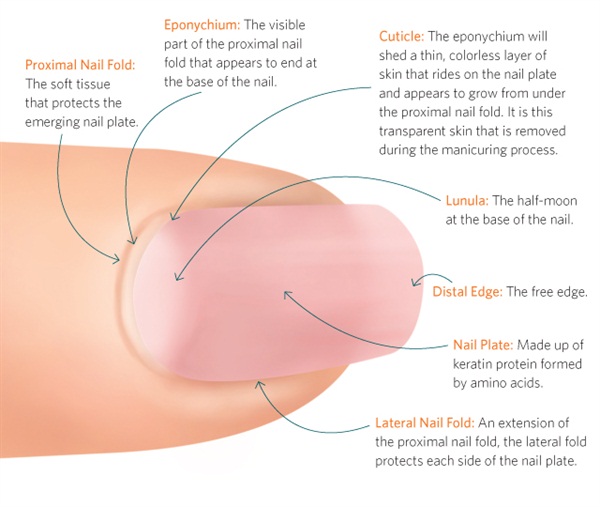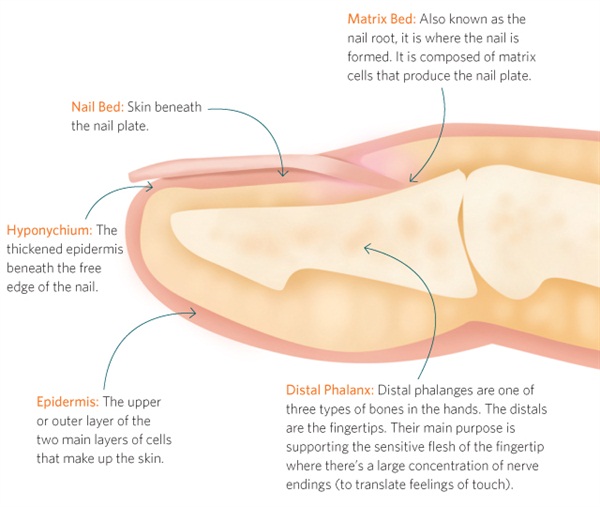Do you know where your cuticle is? It probably isn’t where you think! In this article, we cover some basic nail anatomy, and show you what the different parts of your nail are called, as well as discuss a few do’s and don’ts when it comes to caring for your nails.

CUTICLE
The eponychium sheds thin, colourless layers of skin cells as the nail grows out, and it’s these loose thin cells that stick to the nail plate that are the true cuticle (not the eponychium). During a manicure, your nail technician will remove this layer of transparent skin cells, to improve the adhesion of your polish or enhancement to your nail. See EPONYCHIUM for more info.
DISTAL EDGE
See FREE EDGE.
DISTAL PHALANX
Distal phalanges are the little bones that form your fingertips. They support the flesh of the fingertip.
EPIDERMIS
The epidermis is the outer most layer of your skin. This is the part that you can see and feel on your fingers.
EPONYCHIUM
The eponychium is often what most people call their cuticle, yet it is not the true cuticle. The eponychium is actually a part of the proximal nail fold, and it’s purpose is to form a seal between your nail plate and the proximal nail fold, to prevent bacteria and dirt from entering your body. If the eponychium’s seal is broken, lifted, cut or removed completely, this can expose you to bacteria, which could in turn lead to an infection. Never let anyone “cut your cuticles”, and don’t be tempted to pick this skin off, if it’s dry, rather treat the dryness with a cuticle oil or nourishing hand cream. See CUTICLE for more.
FREE EDGE
Also known as the DISTAL EDGE. This is the part of your nail plate that grows out above the tip of your finger. It is “free” and not still attached to the nail bed.
HYPONYCHIUM
The hyponychium is the thickened layer of epidermis (skin) that lies right at the tip of your finger, snuggled up against the underside of your nail plate. The FREE EDGE starts where the hyponychium ends.
LATERAL NAIL FOLDS
The lateral nail folds are the ends of the fleshy side parts of your finger that surround the sides of each nail. They are extensions of the PROXIMAL NAIL FOLD, and they protect the sides of your nail from trauma and bacterial infection.

LUNULA
The lunula is the half moon that appears at the base of the nail. Not all nails lunula’s are visible, they are often hidden underneath the eponychium. Lunula’s are usually most noticeable on the thumbs and big toes.
MATRIX
The matrix is also known as the matrix bed or the nail root. This is where the nail is formed, and where the NAIL PLATE grows out from. Damage caused by trauma to the matrix is permanent and will often result in the nail plate growing out with white spots (from bumping the matrix), or deep grooves (from permanent matrix damage).
NAIL BED
The nail bed is the layer of skin beneath the nail plate. It’s this layer that nourishes the nail plate and provides it with everything it needs (oxygen, blood supply, nutrients, etc).
NAIL PLATE
The nail plate is the part of your nail that you can see, feel, touch and often apply nail polish to. It is made up of the same keratin cells as your hair.
PROXIMAL NAIL FOLD
The proximal nail fold is the end of the fleshy part of your finger at the base of your nail. This fold of soft tissue protects the delicate new cells of the emerging nail plate, as your nail grows out.
Other articles that you may be interested in reading:
How to file your nails correctly
Do nails breathe?
Nail Extensions
Nail Shapes
Gel vs Acrylic – what’s the difference?
Nails – FAQ

Leave a Reply
You must be logged in to post a comment.